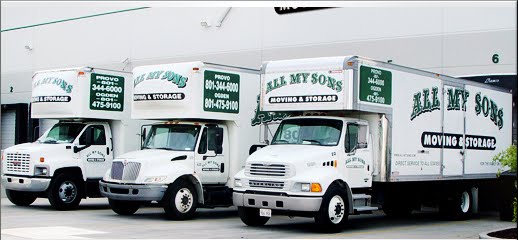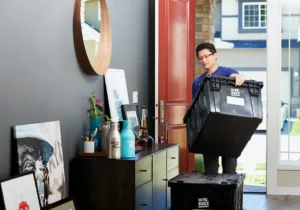Navigating the Moving Process with U-Haul Solutions
April 13, 2024
Moving to a new home or office can be an exciting adventure, but it often comes with its fair share of challenges and stress. From packing up belongings to coordinating logistics, the moving process can be overwhelming without the right support. Companies like U-Haul are here to provide you with reliable solutions and expert guidance on your moving process. In this guide, we’ll explore how U-Haul’s comprehensive moving services expertise can help you navigate your moving process with ease.
U-Haul has earned its reputation as a trusted leader in the moving and storage industry. Founded in 1945 by Leonard Shoen with just a handful of trailers, U-Haul has since grown into a global powerhouse, offering a wide range of services and products to meet the diverse needs of customers around the world. Whether you’re moving across town or across the country, U-Haul provides the tools, equipment, and support you need to make your move a success.
U-Haul offers a comprehensive range of moving solutions to accommodate a variety of needs and preferences. From truck and trailer rentals to moving supplies and storage options, U-Haul has everything you need to streamline your move from start to finish. They have the resources and expertise to ensure a smooth and stress-free moving experience.
When planning your move, it’s essential to choose the right services to meet your specific needs and preferences. Consider factors such as budget, timeline, and level of assistance needed when selecting the services that are right for you.
Once you’ve chosen your moving services, it’s time to start preparing for the big day. Begin by decluttering and organizing your belongings, packing them securely, and labeling boxes for easy identification.
On moving day, follow your plan carefully and enlist the help of friends, family, or professional movers to assist with heavy lifting and logistics. Use U-Haul’s reliable trucks and equipment to transport your belongings safely and efficiently to ensure that everything goes according to plan.
Despite careful planning, unexpected challenges may arise during the moving process. From inclement weather to logistical issues, it’s essential to remain flexible and adaptable in the face of adversity. Lean on U-Haul for support and guidance, and don’t hesitate to reach out for assistance if needed.
Moving doesn’t have to be stressful – with the right support and resources, you can navigate the process with ease and confidence. You can enjoy a seamless and hassle-free moving process with U-Haul from start to finish.
All My Sons Moving and Storage is known for its reliable moving service. To name a few, All My Sons Moving & Storage offers furniture placement, furniture assembly, disassembly, and furniture quilting-pad wrapping. The company operates and provides family-owned moving and storage services.
If you hate loading your dress, you can leave your clothes packed in the dresser and let All My Sons Moving & Storage load it for you. One of the good things about the company is that they have a family feel and they are super friendly approach doing the moving process.
Also, Read: PODS Container: Why We Love Portable On Demand Storage?
All My Sons is known for white-glove moving service; it’s their specialty. The company does all the hard work for you, from moving heavy furniture to loading your belongings safely and securely. They also offer special services when it comes to packing and loading for an extra cost.
One of our favorites about the companyis thats they cover long distances within 60 countries and any part of 16 US states. Hate packing valuable belongings because you are afraid that you might break them? They will handle all the packing and packing while you chill.

All My Sons Moving and Storage professionals were reliable and excellent at what they did. We love the fact that they can provide same-day and next-day moving services. They have all the tools needed to secure, reliable, and protected moving expectations.

Moving to a new home can be an exciting but stressful time. As you prepare for the move, you may find you have more belongings than space at your new place. This often means you need to downsize your possessions. Some items you can donate, sell or throw away. But what about those things you want to keep, but just don’t have room for right now? This is where renting a storage unit can help.
During a move, you have a few options for getting your things into storage:
Ask the movers to make a stop at a storage facility
Rent a truck yourself and move items into storage
Hire a separate moving company just for transporting belongings to storage
This article provides tips on using a storage unit when you are moving, including how to work with movers to get your stuff into storage. We’ll discuss what movers will and won’t do when it comes to storage units, along with your other options. You’ll also learn what types of items are best suited for storage, and how to safely store your belongings. With the right information, using a storage unit during your move can be an easy and stress-free process.
Moving between homes often requires temporary storage solutions. Your old home may need to be emptied before your new home is ready. Or you may only be able to move a portion of belongings at a time due to logistics. Storage units provide a secure place to keep possessions in transition stages.
Renting a storage unit offers flexibility when relocating. You can move items gradually instead of all at once. This comes in handy if your new home won’t be ready on moving day or you need to downsize. Storage gives you time to sort through belongings and decide what to keep vs. donate or sell. Your movers may also lack the space to transport everything in one trip. Short-term storage bridges the gap between moves.
Storage units allow decluttering before a move too. You can free up living space by removing items you won’t immediately need at the new home. The storage facility safely stores them until you’re ready. This makes packing and loading on a moving day faster and easier. Your movers will appreciate transporting a smaller load as well. Using storage units strategically enables smoother moves.
Most professional moving companies are focused on transporting your belongings directly from your old home to your new home in an efficient manner. Their job is to load up all your possessions at your old house, drive to your new place, and then unload everything there.
Going to a storage facility to drop off items is usually outside the scope of their standard moving services. Movers aim to get your items to their final destination as quickly as possible. Stopping at a storage unit along the way would add substantial time and complications to the moving process that they are trying to avoid.
The moving crew likely has other scheduled jobs that day and wants to complete your move in the allotted time frame. They also have an incentive to maximize their productivity by completing as many jobs as possible. Adding extra stops reduces their efficiency and cuts into their profit margins.
For these reasons, most professional movers will not include storage stops as part of their basic interstate or long-distance moving packages. Their job is simply to move your stuff from one house directly to the other, not to handle intermediate storage. So unless explicitly arranged, you should not expect the movers to make a pit stop at a storage unit facility. Handle those logistics separately.
When using professional movers, you can request they make a stop at a storage unit to drop off some of your belongings. This gives you the convenience of having the movers transport items directly to storage as part of their existing route.
Most movers are willing to make a stop at a storage facility along the way if it doesn’t significantly increase the route distance. However, you’ll likely have to pay an additional fee for the added stop, which essentially acts as an extra destination. The fee amount will depend on the mover’s policies but expect to pay at least an extra hour of work.
If the storage unit is located far out of the way from the mover’s planned route between your old home and new home, they may decline the request or charge a higher fee. You may need to compare shops between movers to find one willing to accommodate your storage unit stop for a reasonable price.
When requesting a storage stop, discuss timing and fees upfront so there are no surprises on moving day. Clarify details like how long the movers will spend loading the storage unit and any requirements around providing access. With a bit of planning, having the movers handle storage can take out some of the work of moving yourself.
Many people try to save money by renting a truck and loading their storage unit on their own. This allows you to avoid paying movers to make an extra stop, which can add hours of labor and extra costs. However, it requires more physical effort and time on your part.
You’ll need to separately rent a truck, van, or trailer big enough to hold your storage items. Make sure to properly secure all furniture, boxes, and items so they don’t shift during transport. It’s a good idea to rent furniture pads, straps, blankets, etc. to prevent any damage.
Pack the truck strategically so you can efficiently unload at your storage facility. Back up the truck as close to your unit as possible. Have any necessary tools on hand like a dolly or hand truck to move heavy items. You may also want helpers to assist lifting furniture and boxes.
Take your time unloading and organizing your storage unit so you can easily access items later. Many facilities require you to provide your own lock, so make sure to secure your unit after unloading. Place any fragile items on shelves rather than the floor if possible.
This do-it-yourself approach requires physical exertion and time devoted to packing, driving, and unloading. But it allows you to transport items to storage at your own pace without paying for a moving company to do it. Just weigh whether time or money is more valuable as you determine logistics.
One option is to hire two separate companies – one for the main move and a second company that specializes in loading and transporting items specifically for self storage units.
The advantage of this approach is it gives you more flexibility. The moving company can focus on getting your furniture, boxes and other belongings from point A to point B efficiently. Meanwhile, the storage company is experienced in the best practices for loading units, securing items, and safely transporting goods to storage facilities.
However, hiring two companies can be more expensive overall compared to using just one moving company for the entire job. You’ll have to pay each company for their time and services. Evaluate if the added convenience and expertise is worth the additional cost.
Some key points if using two companies:
Research reputable local moving companies that offer dedicated storage unit transport. Look for companies that are licensed, insured, have good online reviews and affordable rates.
Give each company an accurate inventory of the items they will be handling. This helps them dispatch the proper vehicle size, equipment and number of movers needed.
Have the storage company arrive after the movers have loaded the main truck and departed. This avoids congestion and lets each crew focus on their respective duties.
Supply each company with directions, access instructions and the unit number for the storage facility. Confirm they have the proper access paperwork or locks/keys to get in.
Conduct a final walk-through of the storage unit after unloading to ensure no items have been misplaced or damaged.
Hiring two specialized companies takes coordination but can provide peace of mind knowing professionals are handling the storage aspect of your move.
When it comes time to move items into your storage unit, follow these tips to keep items safe and organized:
Take time to carefully inventory all items before packing them up. Having a detailed list of what is being stored can make retrieving items so much easier down the road. You don’t want to end up searching through dozens of boxes just to find one item. Create a numbered or lettered list corresponding to box contents and keep this inventory list somewhere handy outside the storage unit.
Invest in high-quality packing materials and storage containers. Use clean, sturdy boxes in good condition and bubble wrap or packing paper to cushion items. Label boxes clearly on all sides. For extra protection, place delicate items in plastic bins with lids or wardrobe moving boxes with a hanging rod. The extra expense of quality packing and storage materials is well worth it to prevent damage.
Load storage items strategically. Heavier boxes and bins should go on bottom shelves. Place rarely accessed items in the back and items you’ll need to get to more frequently in front near the door. You can also group similar items together in labeled areas to stay organized.
Pad and anchor furniture pieces and large appliances so they don’t shift around and rub against each other. Use furniture pads, moving blankets, or bubble wrap on corners and tie items down securely with moving straps.
Taking proper care to pack, label, and position items in your storage unit will allow for damage-free storage and easy access when needed.
When moving items into a storage unit, it’s important to consider what types of belongings you are storing and how best to protect them. This is especially true for valuables, antiques, and furniture.
Climate Control for Valuables
If you are storing items like artwork, musical instruments, antiques, or electronics, it’s highly recommended to use a climate-controlled storage unit. Temperature and humidity fluctuations can damage these types of valuables over time. Climate control helps maintain a consistent environment to prevent deterioration.
Leave Space for Furniture
Measure furniture and appliances you are putting into storage and map out where they will be positioned ahead of time. Leave adequate space to open doors and access items. Disassemble furniture when possible to maximize room. Place furniture up on blocks or pellets to protect from moisture. Cover with moving blankets or plastic to prevent dust buildup and scratching.
Properly preparing items for storage based on type will help keep them in good condition until you are ready to access them again after your move.
When you are selecting a storage facility during a move, it’s important to consider the security of your unit and your ability to access your belongings when needed.
Choose a reputable storage company that has secure facilities. Look for storage units with features like coded gate access, video surveillance, onsite managers, and individually alarmed units. Avoid facilities that seem rundown or have no security measures in place. You want to ensure your items are protected.
Also consider choosing a storage unit that will allow you to conveniently access your belongings when you need them. See how their gate hours align with your schedule. Many storage facilities allow 24/7 access with a gate code so you can retrieve items at any time. Some also allow online reservations for moving trucks to simplify accessing your unit. Make sure the facility’s access policies and features will accommodate your needs.
Selecting a storage unit with strong security features and access for when you need it will provide peace of mind about keeping your belongings safe and retrievable during your move. Do your research to find the right storage company for your needs.
Moving can be a stressful time, and deciding what to do with all of your belongings can be a challenge. Using a storage unit during a move is an option that many people consider. Storage units provide a secure place to keep your items, but they also come with extra costs and logistics to manage.
When using a storage unit with a move, you’ll need to consider if your movers can make a stop to load and unload items, or if you’ll need to transport items separately. Loading the unit yourself takes time and effort. Hiring separate movers just for the storage unit is another possibility, but adds expense. You’ll also need to factor in costs for the storage unit rental, and determine how long you’re likely to need it.
There are pros and cons to using storage units during moves. Key advantages include freeing up space in your new home, storing seasonal or infrequently used items, and providing security if you’ll be between homes. Downsides can include extra costs and time needed for transporting belongings. Evaluate your specific moving situation to decide if utilizing a storage unit is right for you. With planning, storage unit move can provide a helpful option when relocating.
This is a nightmare for someone who is trying to relocate and arrives at their new location to find their beloved gadgets cracked or scratched. If you don’t want this to happen to your belongings, hire a licensed mover to advise you on the best packing methods. Another good option is to hire a team of dependable movers to assist you in packing and moving safely. If you plan to pack your hose yourself, here are some packing tips that will come in handy. Of course, it’s not just the gadgets that need special consideration.
Until you start packing furniture and other things, you’ll have a lot of questions and issues to deal with.
If you’re moving internationally, compare the plug and voltage systems in your home country and your destination country to ensure they’re compatible. If that’s the case, do some fast research to see what voltage adaptors your electronics can handle. If not, a major garage sale may be in order. Also, expect to do some digital shopping as soon as you get to your new place.
Are you one of those considerate people who keep the original packaging boxes of their electronics? If not, you’ll have to start searching for matching or at least similar-sized plastic containers or cardboard boxes. The container’s dimensions are crucial. You don’t want to risk scratching or jamming your gear by shifting it back and forth.
You just don’t want it to be crammed inside and break. Electronic stores typically have a variety of sizes of boxes. However, you should start planning ahead of time, at least a few weeks before your Big Move Day.
Also Read: What Are Best Packaging Fillers?
Using as much bubble and wrapping paper as you can to protect your devices if you have to switch at the last minute. Warm clothes, towels, and blankets will come in handy if you don’t have any packing materials. Fold the cords or electronics tightly and tie them to the main body of the device before packing. Ensure that your electronics’ accessories are packaged (preferably in clear plastic bags), signed, and put in the same box as your electronics.
If you don’t take care of the accessories for your electronics, they can become useless in your new home. At least before you locate anything in one of your boxes or purchase a replacement.
There’s another factor that makes electronics incredibly inconvenient to transport, in addition to their high cost, bulkiness, and fragility. Electronics are quickly becoming obsolete nowadays. So, unless you intend to use your Magic Mirror or TV for at least another couple of years, you may want to recycle it or take it to a garage sale instead of shipping it long distance. In some situations, it could be more cost effective to sell an old electronic and purchase a new one to be installed in your new home. It is entirely up to you to make your decision. And you’ll have to make a lot of decisions like that during your relocation.
Stop being too emotional. Pack just what you absolutely need
Check the initial policy and guarantee for each piece of equipment; you might even have moving insurance. Even if it isn’t in a traditional policy, it’s worth double-checking. If your equipment’s warranty does not include moving insurance, you’ll need to negotiate it with your moving company. Prepare all paperwork to assist the moving company in determining the value of your electronics.
Also Read: Moving Company Terminology You Need To Know
Make a list of all the technical equipment, belts, and accessories you have. Mark each piece of electronics with an estimated location in the moving truck or a series of locations. Keep this list until the very end of your relocation. You can discard the list once you’ve checked all, unloaded, settled, plugged in, and successfully started each item. The list of electronics will not only assist you in keeping track of your belongings and resolving any potential problems with movers or insurance, but it will also assist you in finding your remote control or voltage adaptor while unpacking.
Temperature, humidity, and air pressure are all highly sensitive to electronic devices. But make sure you read the whole weather forecast. Even if the forecast says “sunny with no cyclones,” double wrap your devices to ensure that they are sealed and temperature resistant. Don’t be afraid to ask your moving company for watertight trucks or storage containers, and make sure it’s covered by your insurance.
Your moving company would need to know the quantity and size of your most valuable technical pieces. This will assist them in locating a truck that is specially fitted. The safe delivery of your belongings to your new home will be ensured by the wall belts and fasteners of such vehicles. If you’re doing it yourself, though, you’ll have to do the opposite: don’t put heavy, delicate electronics near the walls. Place them in the truck’s center and cover them with soft furniture, pillows, linens, or clothing bags (boxes).
Use separate boxes for the smaller gears, tape and sign them, and mark them “this side UP.” If you’re moving on your own or with a moving company, the UP mark can come in handy for you or the movers when it comes to unloading your container at your new home.
We did our best to provide everything you’ll need for your move, a well-maintained moving checklist to ensure you’re completely prepared and ready to go. The moving companies listed on wowmover.com have been proven to be reliable and provide a wide range of services related to your relocation, including packing and unpacking services, and cost-effective transportation, all you need for a successful relocation.
You’re probably already familiar with the self-storage units we see everywhere if you’re looking to store any things that you just can’t part with but don’t have space for. A new product, however, is officially on the market, which may alter the way we store our belongings. We have compiled a self-storage and POD unit guide so that you can choose which one is right for you.
Self-storage units are the ones that we usually see in town, and when you think about storage, they’re most likely the first thing that comes to mind. Typically, these units pay a monthly fee to operate, and they can be found in large complexes. You’ll be given the number and the key to your unit when you get a self-storage unit, and you can use it any time you want.
One of the main benefits of self-storage is that you can choose from a large variety of sizes. If you want a tiny 8-10 unit or a large 20-30 unit, it is up to you, so you don’t need to pay for more storage space than you’re going to use. In order to avoid water damage to your belongings, most of these systems are often climate-controlled and sealed off, and you can choose whether you want a garage-like unit or an indoor unit. These facilities are nearly everywhere, so you’re sure to find one in your city.
Also Read : The Ultimate Guide to Storage Unit
Traditional self-storage has a few downsides. Any time you want to bring anything in or take something out, you will have to go to the unit instead of making it come to you. Once to move it into the device and again to move it out, you will also have to load and unload your things twice, which means it can become costly. Finally, it can be tempting to forget about your storage unit and keep your stuff there longer than you initially intended, and after you’ve put your items in it, you may be tempted not to give up the unit.
A very recent trend in the storage industry is portable storage units, and they are rapidly gaining popularity. These are portable metal units that are dropped off at your door for you to fill and then picked up once your things are safely packed inside to be taken to a POD warehouse.
Transporting PODs can be much faster, and they come straight to your door. Depending on how much space you need, you can pick different sizes, and you just have to pay for a transfer instead of two.
PODS costs more than self-storage, and since you want to keep the device at your house, the monthly rate would be higher. In unit sizes, there is often less variety, so depending on how many belongings you plan to store, you can have to pay for different units.
You can rely on our Moving and Storage if you need help moving or storing your belongings. For almost any form of move, we provide moving facilities, and our self-storage units are secured and protected by 24/7 security cameras.
For a free quote on your next move, call us at (888) 534-2250
Related Articles:






Moving straps heavy items can be a daunting task, but with the right tools and techniques, it can become much easier and safer. One such tool that can make a significant difference is this.
Moving straps simplify the process of lifting and moving heavy objects. They can be used for DIY moves or for rearranging furniture at home. In this comprehensive guide, we will walk you through everything you need to know about how to use moving straps effectively and safely.
Also known as furniture lifting straps, are specialized tools that leverage the principle of leverage to distribute the weight of heavy objects and reduce strain on your body. These straps are typically made of durable nylon material and are designed to be worn either on your shoulders or forearms, depending on the type of moving straps you choose.
Two main types of moving straps exist shoulder straps and forearm straps. Shoulder straps consist of a harness that fits over your shoulders and a detachable lifting strap. They evenly distribute weight on your shoulders, so you can lift heavier things.
On the other hand, forearm straps have loops on each end that you slip your forearms into. These straps are ideal for maneuvering smaller and lighter items, such as mattresses or chaise lounges.
Can be used in various situations where you need to lift and transport heavy objects. However, they are particularly useful when navigating stairs or tight spaces where traditional moving equipment like dollies may not be practical. The best moving straps can help you maintain control and balance while reducing the risk of injury.

Using moving straps offers several benefits, including:
To ensure you use the straps effectively and safely, follow these essential tips:
Before using your moving straps, it’s crucial to read and understand the instructions that come with them. Each brand may have specific guidelines and recommendations for proper usage, so familiarize yourself with the instructions to avoid any potential injuries.
Before attempting to lift any heavy objects with moving straps, clear the pathway from your starting point to your destination. Remove any obstacles, such as rugs or toys, that could pose a tripping hazard. Additionally, measure doorways, hallways, and staircases to ensure the item you’re moving will fit through without any issues.
Wearing appropriate clothing and footwear is essential when using moving straps. Opt for sturdy, non-slip shoes to maintain grip and balance while lifting. Avoid open-toed shoes or high heels, as they can increase the risk of accidents. Additionally, wear comfortable and non-constricting clothing to ensure freedom of movement.
Typically requires two people. Find a reliable moving partner who can assist you in lifting and maneuvering heavy objects. Working as a team will ensure better control and reduce the risk of accidents.
Depending on the type of moving straps you have, determine the appropriate placement for optimal lifting. Shoulder straps should be positioned over your shoulders, with the lifting strap centered in front of your body. Forearm straps should be positioned around your forearms, with the lifting loops securely fastened.
To prepare the object for lifting, place the straps on the ground in front of the item. With your partner’s help, tilt the object back gently to create enough space to slide the straps underneath. Ensure that the straps are centred and properly aligned with the object.
When lifting the object using straps, it’s crucial to use proper lifting techniques to prevent injuries. Bend your knees, keep your back straight, and lift with your legs rather than your back. Coordinate with your partner to lift the object simultaneously and maintain clear communication throughout the lifting process.
Once you have lifted the object using the moving straps, move slowly and carefully to your desired destination. Take small steps and communicate with your partner to ensure synchronized movement. If either of you needs a break or adjustment, lower the object safely and resume when ready.
When you reach your destination, lower the object slowly and with control. Bend your knees and keep your back straight to reduce the risk of strain or injury. Remove the straps carefully once the object is safely on the ground.
Yes, moving straps can significantly assist in lifting and moving heavy objects when used correctly. They help distribute the weight, reducing strain on your body and making the process more manageable.
Some moving straps are designed for one-person use, while others require two people. Check the specifications of your specific set of moving straps to determine if they can be used individually.
Moving straps can be used for a wide range of heavy objects, including bookcases, couches, desks, tables, and more. They are versatile tools that can make the moving process easier and more efficient.
The weight capacity of moving straps can vary depending on the specific style, model, and brand. Generally, can support anywhere from 400 to 650 pounds, but it’s essential to check the manufacturer’s guidelines for the specific straps you are using.
Moving cost straps are widely available for purchase at home improvement stores, such as Lowe’s and The Home Depot. You can also find them online through various retailers.
Using moving straps can make a significant difference in the ease and safety of lifting and moving heavy objects. By following the tips and techniques outlined in this guide, you can effectively use to reduce strain on your body and prevent injuries. Remember to always prioritize safety, communicate with your moving partner, and use proper lifting techniques. With the help of straps, your next move or furniture moving straps rearrangement project will be a breeze.
Moving can be stressful, overwhelming, and costly, whether you’re moving across the world or just down the street. As compared to hiring movers, renting a U-Haul will save you a lot of money, but if you pay attention to the specifics, you can save even more.
When it comes to choosing the correct size truck or van, don’t guess. Take measurements of your rooms to get an idea of how much you’ll be bringing. Depending on the destination, the cost difference between a 1-room truck and a 3-room truck can be hundreds of dollars.
U-Haul is not a good place to get boxes. Request boxes from every liquor store and grocery store in town. Ask about their delivery day and offer to assist them in breaking down the boxes. Check through dumpsters for clean boxes. If you don’t have a lot of boxes, stuff as many as you can into dresser drawers, plastic storage containers, and other containers you have. You’ll be shocked by how much you can fit into your existing belongings.
It might seem strange, but if you’re renting a U-Haul for a one-way journey, it may be cheaper—in some cases, much cheaper—to drive to your new home and then to a city even farther away, if it’s larger. Returning trailers to very small towns will increase the cost of your rental by up to 50%.
Using your own blankets and rugs as padding between wooden furniture pieces will save you a lot of money. Instead of renting expensive blankets from U-Haul, you can strategically position boxes and cardboard in the van.
Between Sunday and Thursday, rates are usually lower.
Consider how much you really ought to bring with you if you’re toting around furniture that’s seen better days. Examine everything you own to see if it really wants to accompany you on your journey. Reduce the amount of luggage you carry to reduce the size and expense of the truck you’ll need to hire. Perhaps you’ll make enough money at the sale to cover some of your moving expenses.
Also Read: How to Properly Secure your Furniture while Moving
Borrow a tow dolly or refrigerator dolly from a friend or a local business instead of renting one.
If you can rent your truck for a day or two and return it to the same location where you rented it, you can save a lot of money. Calculate the cost of transporting the truck one way or returning it to the same location using the U-Haul website or by calling and asking a representative. You can save hundreds of dollars if you are just traveling a short distance, such as within the same state or area.
Related Articles:






Moving is always a hectic process that requires careful planning. While professional moving companies can transport most household items, there are certain restricted items they cannot legally accept due to safety regulations or the risk of damage. Let’s look at some of the most common materials that are prohibited on moving trucks.
Hazardous materials including flammable, explosive or corrosive substances present serious risks if not properly contained and require special permits. Consequently, movers cannot transport:
It’s always safest to have gas grill tanks and fuel drained professionally before moving. Ammunition should travel securely stored in your personal vehicle.
Items that are ultravaluable, fragile or perishable are best kept with owners in their vehicle rather than on a moving truck. Prohibited items include:
While movers have insurance, such valuables are best protected when transported by the owner present. Pets should travel in personal vehicles when possible for comfort and safety.
While beds, couches and dressers present no problem, certain major appliances require advance disconnection and securing that most moving companies don’t offer. These include:
It’s prudent to hire separate certified specialists to disconnect, prepare and reload such appliances professionally on site.
While TVs and compact audio/visual items aren’t an issue, moving certain electronics demands technical skill and precautions movers may not have. Some prohibited examples:
Consult with electronics professionals on safe packing, transportation and reinstallation of sensitive equipment to prevent damage or malfunctions.
Unless disassembled properly, large assembled furniture poses logistical challenges. Prohibited items include:
Book a separate service through the movers or local craftsmen to safely dismantle oversized intact furniture for reassembly at destination.
A few other less obvious restricted materials are:
Common sense dictates double checking all items to make sure nothing dangerous, excessively heavy or difficult to handle safely on a moving truck is included without proper preparation and transportation planning. With properly restricted items, the move goes much smoother!
So what should you do with prohibited materials when moving? Here are some options:
With careful assessment and planning, all household contents can still make the journey to the new home with a little creative logistics. Don’t wait until moving day to address restricted substances – prepare well in advance.
Damage can still occur even with the utmost care. It’s wise to ensure prohibited valuables are sufficiently covered:
Knowing liability in advance eliminates surprises and assures adequate protection for precious restricted cargo during transit. Planning is key for a smooth move.
In conclusion, communicating with moving companies beforehand allows safe handling of all but the most hazardous or difficult to transport items. With the proper preparations and precautions discussed, even prohibited belongings can still make the journey to the new home intact. A little extra effort upfront eases stress down the road. Safe travels!
Moving to a new place can be an exciting adventure, but the process of packing up your life and relocating can also be incredibly daunting. One of the most challenging aspects of moving is figuring out what to do with all the unwanted items you’ve accumulated over the years. Whether you’re moving across town or across the country, it’s essential to declutter your belongings and streamline your possessions. In this comprehensive guide, we’ll walk you through practical and eco-friendly ways to get rid of unwanted items when moving. By the end of this article, you’ll have a clear plan of action to make your move smoother and more organized.
Before diving into the specifics of how to get rid of unwanted items, let’s discuss why decluttering is crucial before a move. When you lighten your load, you reduce the volume of belongings you need to pack, saving time, effort, and money. Additionally, moving fewer items can lower your moving costs, especially if you’re hiring interstate moving services. Here are some benefits of decluttering before a move:
Decluttering allows you to assess your belongings objectively. Identify items you no longer use, need, or love. Streamlining your possessions ensures you only bring items that hold value and are essential to your new home.
Most moving companies calculate their fees based on the volume and weight of your belongings. By decluttering, you reduce the number of items to be moved, potentially leading to significant cost savings.
Moving can be stressful, and dealing with unnecessary items adds to the anxiety. Decluttering helps create a calm and organized environment, making the moving process smoother and less overwhelming.
Now that you understand the importance of decluttering let’s explore various methods to get rid of unwanted items responsibly.
Recycling is an eco-friendly way to dispose of items like electronics, paper, glass, and plastics. Many communities offer recycling services for residents. Contact your local recycling center to learn about the items they accept and their collection schedules. Remember to properly clean and prepare items for recycling to ensure they can be processed efficiently.
Donating items is a wonderful way to give back to the community while decluttering your home. Clothes, furniture, toys, and household items in good condition can find new homes through local charities, shelters, or thrift stores. Research charitable organizations in your area and schedule donation pickups or drop-offs.
For items that are no longer usable or recyclable, consider hiring junk removal services. These professionals can efficiently dispose of large and bulky items, saving you time and effort. Junk removal services responsibly dispose of items, ensuring they are properly recycled or sent to appropriate landfills.
Hosting a garage sale is an excellent way to declutter while making some extra cash. Gather items you no longer need, set reasonable prices, and advertise your sale in local online classifieds or community bulletin boards. Be sure to clearly label items and have enough change on hand. Whatever doesn’t sell can be donated or recycled.
Moving can be a transformative experience, and decluttering your home before the big day can make the process much more manageable. By following the tips outlined in this guide, you can responsibly and efficiently get rid of unwanted items, making your move smoother, more organized, and eco-friendly. Remember, recycling, donating, and using junk removal services are all viable options for disposing of items in an environmentally conscious way.
For professional interstate moving services, recycling guidance, or junk removal assistance, visit WowMover. Their experienced team can help you with all aspects of your move, ensuring a stress-free and environmentally friendly relocation experience.
By following these steps, you’ll not only simplify your move but also contribute to a more sustainable future by responsibly handling your unwanted items. Happy moving!
Are you planning to move to a new place? Whether it’s a local move or a long-distance journey, you might be tempted to save some money by taking the DIY route. After all, moving on your own seems like a cost-effective choice, right? Well, think again. In this article, we’ll delve into why DIY moving can often be a waste of time, money, and effort. We’ll also explore some alternatives that could make your move a breeze.
One of the first challenges you’ll encounter when moving on your own is the heavy lifting. Moving furniture, appliances, and boxes can be backbreaking work. Not only can it lead to physical injuries, but it also consumes a significant amount of your time. Wouldn’t it be nice to have a professional team take care of this for you? Companies like Two Men and a Truck specialize in just that.
Moving requires careful planning and organization. Packing your belongings, disassembling furniture, loading a truck, and driving to your new destination can take up an enormous amount of time. If you factor in the time you’ll need to take off work, it can end up costing you more than you’d expect. Professional moving services can save you precious time, allowing you to focus on other essential aspects of your move.
Some might consider renting a trailer for DIY moving, thinking it’s a cost-effective solution. However, trailer rental comes with its own set of challenges and hidden costs. First, you’ll need the necessary equipment to tow the trailer, which might require you to rent or purchase a hitch and other accessories. Moreover, you’ll be responsible for driving a larger vehicle, which can be stressful and even dangerous, especially if you’re not used to it.
While contemplating DIY moving, some individuals might think about cutting costs by living inside a storage unit temporarily. However, it’s essential to be aware that this practice is illegal in many places. Not only does it pose safety concerns, but it also raises ethical questions. Living in a storage unit can have severe legal repercussions and can lead to eviction from the facility.
Moving pods, also known as portable storage containers, are another option that might seem attractive for DIY movers. While they offer convenience, they come with their own set of challenges. Loading and unloading a moving pod can be physically demanding, and if not packed properly, your belongings can get damaged during transit. Get answers to frequently asked questions about moving pods and learn some valuable tips at Facts About Moving Pods: FAQs, Cost, and Tips.
If you want to avoid the drawbacks of both traditional DIY moving and moving pods, consider using professional moving containers. These containers offer a perfect balance between convenience and cost-effectiveness. You can pack your belongings at your own pace, and a team of experts will handle the transportation.
Moving is a complex task that involves a lot more than just transporting your possessions from one place to another. Professional movers have the expertise and experience to make your move smooth and stress-free. Here are some compelling reasons to hire professionals for your next move:
While DIY moving might seem like a cost-effective option, the hidden costs and challenges it presents often make it a waste of time and effort. Instead of struggling with the heavy lifting, time-consuming planning, and potential legal issues, consider the value of professional movers. They can provide expert assistance, saving you time, money, and stress, ultimately making your move a breeze.
In summary, the benefits of hiring professional movers, such as Two Men and a Truck, far outweigh the hassles of DIY moving. Whether you opt for moving containers or traditional moving services, you’ll find that your move can be efficient and cost-effective without the DIY headaches. So, if you’re planning your next move, take a moment to explore the alternatives before deciding to go the DIY route. Your back and your wallet will thank you!